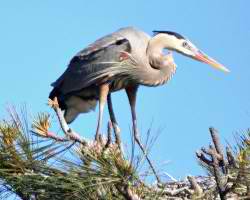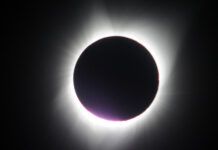It’s breeding season for great blue herons along the Pacific coast and visitors to Chula Vista’s Bayside Park have enjoyed observing several active nests in the trees that define the small colony there.
Great blue herons are widespread throughout North America and are found as far north as Alaska and as far south as the Caribbean and South America. They are year-round residents on the Pacific coast.
Their hardiness allows them to adapt to any wetland habitat within their range. Their primary diet includes small fish, though they are known to also opportunistically feed on a wide range of shrimp, crabs, aquatic insects, rodents and other small mammals, amphibians, reptiles and small birds, according to an article posted on Wikipedia. Their primary prey is variable based on availability and abundance.
Colonies can include anywhere from five to 500 nests and usually are placed in areas where it is difficult for humans to approach on foot. Nests are usually found on islands, trees in swamps and in high branches for protection against mammalian predators.
Great blue herons raise one brood each year. Eggs are laid in March and April and take about 27 days to hatch. Several chicks have already had time to mature and flutter their wings in readiness for flight. The chicks grow fast. By the time a chick is 45 days old, it has already reached 86 percent of its adult body mass. Young herons usually take their first flight away from nests after 80 days and begin following adults to foraging grounds for several weeks thereafter before dispersing as winter approaches.
Not surprisingly, the small colony of great blue herons has provided local photographers with a plethora of imaging opportunities, especially during feeding time. One intrepid photographer even used a drone to photograph the nests from an aerial vantage point.
The herons return annually and this group is believed to have grown to its current size from egg-laying adults about seven years ago, according to regular park visitors.
Photo-journal entry by Ron Becijos
Sometimes a casual bike ride can provide more than healthy exercise. While stopping for a moment to admire the shore at Chula Vista Bayside Park, local resident Chris Davis and her mom Irene pointed out her discovery of the amazing blue heron colony nesting in the park’s pine trees. I wasted no time riding back to my car to retrieve a camera and return to begin photographing while Chris pointed out six or seven active nests, with most of the chicks in the fledgling stage (the stage when the chicks have acquired the proper feathers necessary for flying, and are ready for independent activity). Their feathers are expressed in deep colored hues and are a spectacular sight when presented in a full wing display.
Quickly, I found that the loud staccato squawks by the chicks signaled that it was feeding time. Each delivery by the parent became a mesmerizing blur of feathers and whirling beaks for several minutes until the parent retreated from the nest and once again returned to wade in the nearby shallow water in search of more food.
These great herons are an amazing view whether in their nests, the wetlands or in flight. They are the largest waders of tthe North American herons and usually begin their nest building and egg laying in February and early March. After hatching they grow to adult size in about six weeks when they become ready for fledging. Bayside Park has been host to small colonies for about seven years running according to visitors who frequent the park.
The next time you visit this unique site adjacent to the marina boat launch, scan the beautiful wetlands, and then lift your eyes to the tree tops and the sky, and you might be fortunate enough to spot a magnificent great blue heron.















